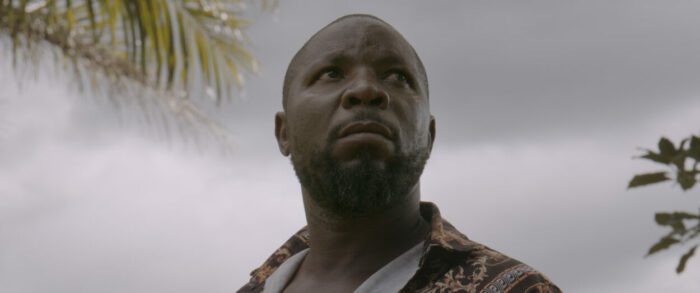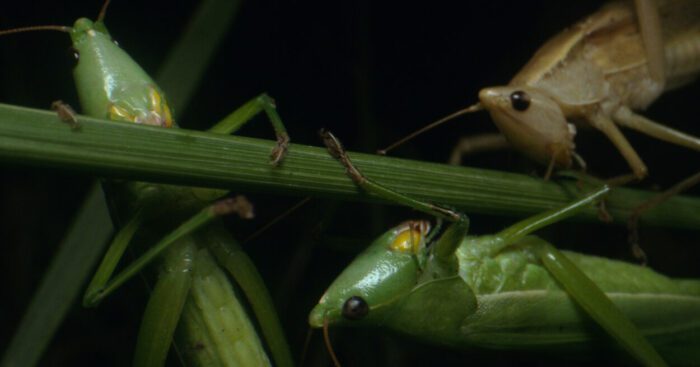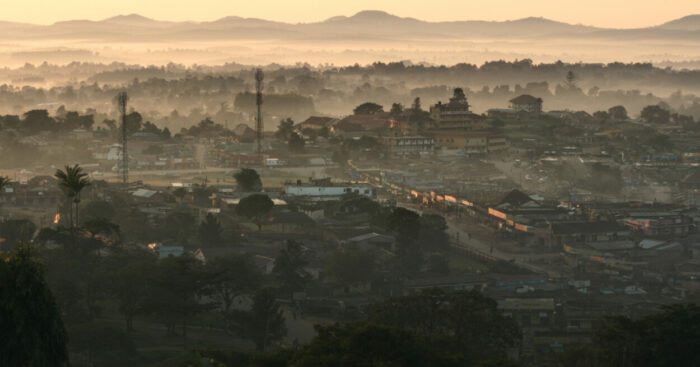Where I live, grasshoppers are both a necessary element of the region’s ecosystem and an occasional nuisance on the bike paths. (Best to ride with mouth closed in late summer, I’ve learned.) Farmers dread them, acridologists study them, artists employ them as symbols, and in some parts of the world, to my culinary incredulity, people dine on them. In Uganda, in particular, fried grasshoppers are a sought-after delicacy. However, harvesting the grasshopper is no simple matter. Doing so involves a complex, practically byzantine set of high-risk tasks, ones charted in detail by the immersive, fascinating, and appalling verité documentary Grasshopper Republic.
American director and cinematographer Daniel McCabe spent three seasons following a team of grasshopper trappers led by a man named Siraje and his right hand man Tabula in the Ugandan rainforest. Like modern-day prospectors mining for gold nuggets, these trappers construct Goldberg-like contraptions designed to thwart nature. To attract the grasshoppers—the Nsenene, a bush cricket which migrates en masse twice yearly following the rainy seasons in an intense swarm—Siraje and his crew tote their jerry-rigged generator and gear to maize and banana plantations.

There, they negotiate with the landowners to set up their generator, which powers unfiltered high-intensity fluorescent bulbs, with a thicket of crisscrossed electric wires. Those lights disorient and attract the insects; massive iron sheets, coated with flour, set the grasshoppers sliding down into the oil drums where they are captured, then bundled and trudged off to market.
It’s tough, tough work, physically arduous and dangerous. The men move the heavy generator across muddy terrain with no protective gear, and the combination of insect dust and intense fluorescence engenders an ugly skin rash. Yet, there’s real money involved, and a big harvest makes the payoff worth the pursuit. McCabe’s film presents the whole cycle of trapping and trading with an immersive, expressly cinematic, even artful approach that both fascinates and appalls.

There are, in Grasshopper Republic, no talking-head interviews, no lower-third chyrons, no graphic representations of data, no explainers of any sort. Instead, McCabe focuses on the contrast between the fortune-hunting grasshopper trappers and their prey. Crosscutting between the Ugandan men with their elaborately concocted schemes and the close-up macro-lensed world of the grasshoppers, Grasshopper Republic presents a stunning visual and auditory juxtaposition of the two worlds.
The close-ups, shot in remarkable proximity with brilliant color and mesmerizing movement, offer a bizarre parade of the remarkable creatures that comprise the insect world. At times, the insects’ labor is cut directly against that of the humans, creating a stark and pithy parallel between the two. The fluorescent lights used in trapping cast a sickly green funereal pallor over the trappers, and when the swarm reaches peak intensity, the screen is filled with white sparkles dotting the green night sky, looking a little like CNN’s coverage of the Gulf War bombardment of Iraq. Every image in Grasshopper Republic, even those intended only to frame a moment of stasis or establish a setting, is artfully, perfectly composed.

If McCabe’s remarkable cinematography—both of the the trappers and the trapped—deserves special acclaim here, so does the editing. To make a complex story coherent without overt or nondiegetic narration takes a special skill, and Grasshopper Republic is adroitly edited to present its story nearly wordlessly. Some dialogue between the men provides a brief overview of the task, and Siraje makes for a charismatic if not necessarily verbose point-of-view character. But for the most part, editor (and producer) Alyse Ardell Spiegel weaves together footage from three harvest seasons into a single narrative with a taut pace and clever cuts that raise serious questions about the ethics and consequences of the actions unfolding onscreen.
Composer Robert Aiki Aubrey Lowe’s musical score unfolds subtly at first, then more occasionally, and at the film’s climax, in a crescendo that matches the frenzied cacophony of the final harvest. His modular synthesizer creates an eerie, dystopian vision complementing McCabe’s visuals. Grasshopper Republic‘s is a small team, shot with only McCabe and two assistants on camera and a field entomologist (Francis Sengendo) credited, but its end result is as expressly cinematic, visually arresting, and ultimately thought-provoking documentary as you’ll see.

Without saying so overtly and using the specific to stand in for the general, Grasshopper Republic raises a series of questions about the environment we inhabit, whether our neighbors consume or disdain grasshoppers. For Siraje and others like him, the harvest is a means of survival, but where he profits, others suffer. The means of entrapment may have serious consequences for the both the crops the locals harvest and the men and women who inhabit the land: in one way, Grasshopper Republic, through its relatively simple narrative and its remarkable visual imagery, asks us to contemplate the tendency of unfettered capitalism to corrupt and that of humans to endanger themselves, their fellow humans, and their environment, all for the sake of a few dollars that come from a harvested sackful of insects.




